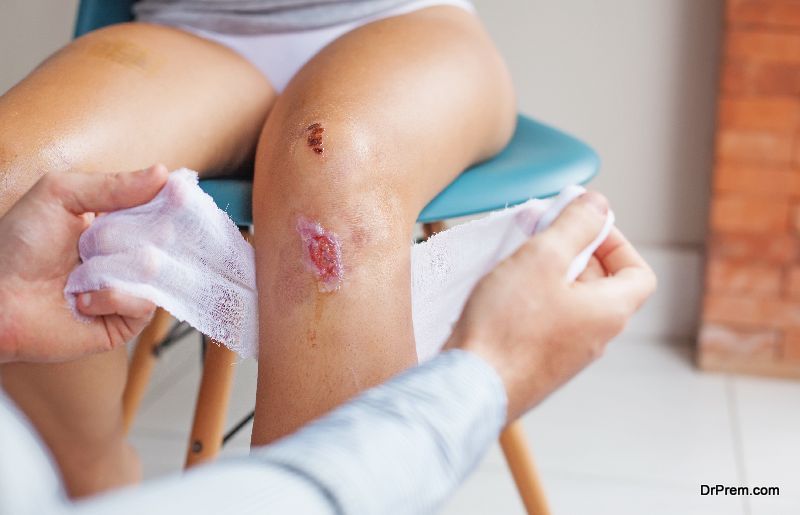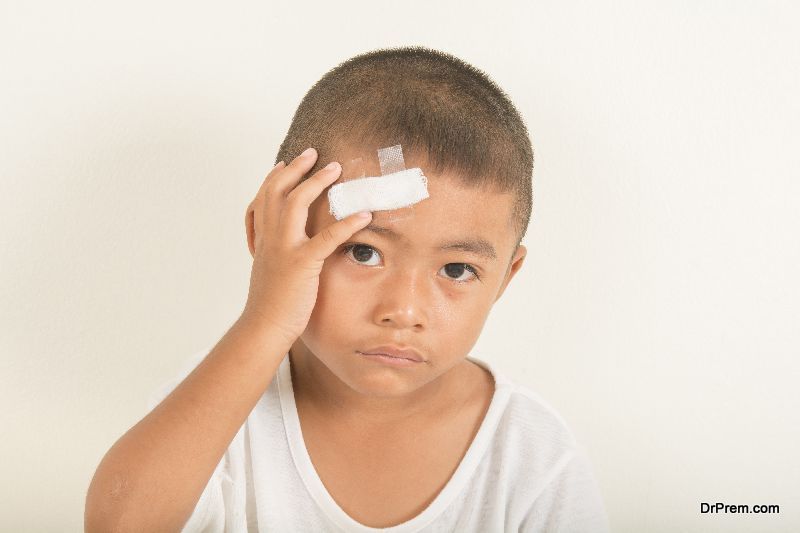Kids are naturally accident prone. Whether they’re just starting out and finding their footing, or are daring and adventurous, bumps and bruises are bound to happen!
But as parents, we need to keep our cool and react calmly when faced with blood – or worse! Here we’ll examine the best ways to handle your child’s most common injuries either at home, on the playground, or at the playing field.
Bump on the Head
This type of injury can happen to children both young and old. When a child is first learning to walk, stumbles and tumbles are to be expected.
If your child falls and bumps his head on a piece of furniture, the floor, or wall, don’t be alarmed. Your child will likely cry, and this is okay. One of the worst things parents can do is overreact when their child is injured. This only causes increased fear and distress in your little one. Calmly assess the situation. If your child has a bump, apply ice to the area every 10 minutes for about an hour to help reduce swelling.
The most crucial steps are actually taken hours after the injury occurs – this holds true for both small children with minor bumps and older children with more severe or traumatizing bumps. Take notice of your child’s eyes – ensure that their pupils look normal. Ask them if they feel dizzy, nauseous, or light headed. These can all be signs of a concussion. If you suspect your child has a concussion, seek medical attention.
One myth about treating a potential concussion is that your child cannot sleep. Don’t try to keep your child awake if they want to rest. But, be sure to monitor them while they’re sleeping. Every 30 – 60 minutes, gently rub your child’s back to make sure they move, roll over, or react in some subtle way to your touch. This indicates they are safely sleeping and not unconscious. It’s also recommended to limit your child’s screen time and physical activity following a head injury. Your doctor can make further recommendations.
Cut or Scrape
Just like head bumps, cuts and scrapes are one of the most common minor injuries children face. They can happen while running on a hard surface or coming in contact with a sharp object, just to name a few.
If your child’s wound is actively bleeding, you’ll want to apply direct pressure to the area using a clean cloth. The bleeding should slow or stop completely after approximately 10 minutes. If you cannot get the bleeding to stop, or the wound is deep, you should seek medical attention. Your child might need liquid stitches or glue to help close the cut.
If the bleeding does lessen within a few minutes, you can begin first aid. Remove any debris or dirt from the affected area and clean the skin using soap, and water. Pat the area dry before applying antibacterial ointment and either an adhesive strip or other type of bandage. It is not suggested that you douse the wound in peroxide or alcohol. This will be painful for your child and quite unnecessary as well.
Burns
No matter how careful we are with children and hot surfaces, burns happen. Whether it’s in the kitchen or around the campfire, you’ll need to use quick thinking and the right materials to treat a minor burn.
The first thing you’ll want to do is run cold water over the affected area. This should provide your child with initial, immediate relief. Once the pain subsides, pat the area dry. Examine the skin for any blistering. This is common, so don’t be alarmed. If the burn is severe or covering a large area, call emergency services immediately. If the skin shows only redness and small blisters, apply a cold compress for as long as your child likes or will allow. Next, cover the burn with a dry sterile gauze or a bandage.
Fight the urge to apply any type of topical ointment to the burn. This can actually trap heat and cause further complications. Do not apply direct ice to the area either. This can cause another burn on top of what your child is already experiencing. If at any point the burn begins to ooze or worsen, seek medical attention.
Bloody Nose
Nosebleeds are common for many children. Sometimes they occur due to trauma or injury, while other times dry heat and other factors can make nosebleeds part of a child’s everyday life. Because the nose can expel a lot of blood, it can be frightening for both the child and parent. It’s important to stay calm and follow these steps when handling a nosebleed.
Have your child tilt their head slightly forward – NOT backwards like many people believe. Tilting your child’s head back will cause the blood to flow from the sinuses down their throat. Not only does this taste awful, it can lead to choking and difficulty breathing. Pinch the bridge of your child’s nose at the top, between the eyes for about 10 minutes to see if bleeding lessens.
If the bleeding continues, replace any soiled tissues or paper towel with fresh, dry pieces and continue the process. You can also try applying ice or a cold compress to your child’s nose, cheeks, or back of the neck. This can help constrict the blood vessels and slow down the flow of blood. Do not stick any type of tissue or towel in your child’s nostrils. This may stop the bleeding for a few moments, but once removed, the tissue can dislodge any clots that have formed and restart the bleeding. If your child’s nose bleed doesn’t stop or lessen significantly within 20-30 minutes, call a medical professional. Your child might need their nose cauterized – a process that involves sealing the blood vessels to create scar tissue and prevent further nosebleeds.
Stay Calm
The most important part of treating any type of injury in children is to remain as calm as possible. A child often reacts to your reaction more so than to the injury itself.
Assess the situation as quickly as possible. Once you determine if you need immediate medical assistance or the injury can be treated on its own, you can proceed with the necessary steps.
Accidents and injuries are all too common in kids, but knowing how to handle these sometimes stressful situations can mean the difference between at home treatment and a trip to the emergency room.
Article Submitted By Community Writer






